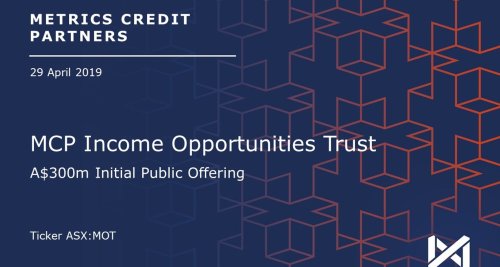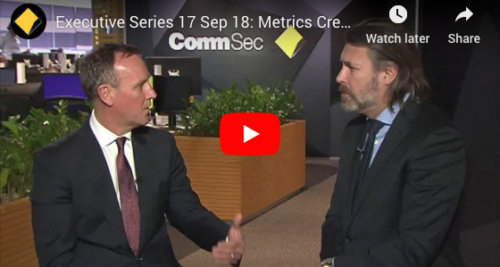Livewire Income Series: The Metrics recipe for reliable returns
At face value, identifying winners sounds like it should be at the core of all investment strategies. What is the growth outlook, does an industry have a good structure, and who are the likely winners?
But for Andrew Lockhart and the team at Metrics Credit Partners, picking winners doesn’t form part of their process. The Metrics team are more concerned with figuring out what happens to earnings at the low point of a business or economic cycle.
We’re looking at the complete reverse: in times of economic stress, what is the bottom of the cycle in terms of valuations and earnings that might put investor capital at risk?
According to Lockhart, this laser focus on understanding the worst-case scenario is the key to delivering steady income and preserving capital.
Metrics is the pioneer in the new breed of non-bank lenders that have emerged in the wake of the Global Financial Crisis as major banks retreated from direct lending activities.
Since launching its first wholesale fund in 2013, Metrics has grown its assets under management to ~$10 Billion via a suite of products to include two listed investment trusts, MXT and MOT, an unlisted retail fund, Metrics Direct Income Fund, alongside a swag of unlisted wholesale trusts.
Lockhart says the firm completed well in excess of $1 billion of new loan transactions in the first quarter of this financial year and has a healthy pipeline of investment opportunities. In this interview, he discusses where some of these opportunities lie and how Metrics is positioning its funds.
Can you introduce Private Credit and why is it a compelling opportunity?
This asset class does a number of things that are attractive for investors. It provides for stability and preservation of capital. It also reduces the correlation to public markets.
For retirees, the ability to preserve capital to generate income is of real appeal. Also, people are concerned about things like volatility in equity markets.
The other concern is inflation. People want to know how to preserve their capital to give them an income long-term if inflation begins to rise.
People have seen the performance of public market securities – equities and bonds – and have become discouraged with how they have performed in difficult times.
What people have seen with us is the consistency of the protection and preservation of investor capital and delivery of attractive income through directly lending to companies.
The world of private credit is not a homogenous market. It gives investors exposure to debt financing outside public markets.
For us, examples include:
- Lending to listed corporates.
- Lending to investment-grade and sub-investment grade corporates.
- Project-based lending, eg, debt financing of an infrastructure asset or large scale commercial property asset such as a residential high-rise building.
- Acquisition financing
In the Australian market, most companies are unrated, and there is no deep non-bank source of financing. Private lenders in the Australian market work alongside and compete with the banks to provide debt financing to companies. That might be senior debt, subordinated debt or mezzanine debt. It could extend from vanilla investment-grade performing loans, all the way through to more aggressive lending strategies, where you lend at different parts of the capital structure or on more aggressive terms to generate a higher return.
It’s important to recognise that debt finance in the capital structure gives lenders a greater level of protection than equity capital investors.
Investors can pick from the full spectrum – from performing credit to non-performing distressed or aggressive lending.
Investors can determine their return objective, understand the risks of pursuing that return, and consider options of how they can access the opportunity.
A lot of people think lending money is easy. You often hear the expression, “If something goes wrong, the borrower will hand back the keys.”
It’s not as easy as that. The corporate insolvency and restructuring process is difficult and complex to navigate.
The expertise of a manager in private debt differs from that of many other asset classes.
Other managers might rely heavily on macro-economic data and years of experience in trading, timing and stock picking. Lenders have to understand what drives cash flow and the risks associated with providing funding for a specific purpose. They must also know how to structure appropriate controls to get your money back if things deteriorate.
What are you and the team debating at the moment?
The number one thing is ESG (environmental, social and governance) and its ramifications. ESG has always been a focus of our business, but the market for sustainability-linked financing for companies is growing very quickly.
We’re investing to position ourselves so we can increasingly lend to companies committed to achieving ESG outcomes that are strictly assessed against key performance indictors (KPIs) delivering real impact.
The other area of focus is the risk of inflation and ensuring that investors understand that private credit in floating rate format can protect them.
We’re also broadening our investor base among institutional, retail and offshore investors looking to access the Australian market.
The final piece is obviously that equity markets have run up very strongly and we’re subject to continuing lockdowns so we need to consider how business and economic conditions might unfold.
Until recently our activities have focused on the corporate institutional part of the market. Now we’re looking at the short and longer-term impacts on businesses and how we can support small and medium-sized enterprises, particularly those that can bounce back and grow strongly.
Are you seeing a trend to finance ESG projects?
Yes. The Asia Pacific Loan Market Association has recently released a set of principles to guide sustainability-linked lending.
That gives lenders confidence around their capacity to structure and originate loans, and put in place appropriate KPIs for borrowers that will deliver the greatest level of ESG impact.
Independent testing and benchmarking ensures that companies are actually delivering the ESG performance they’ve committed to.
If they fail to deliver their KPIs, there may be a pricing impact, but if they meet them, borrowing costs may be reduced.
The reduction in price isn’t massive. This is about ensuring that you’re getting an impact and that companies understand that good ESG practices are important to lenders.
These aren’t wishy-washy terms and conditions that are all one-sided, for the benefit of a borrower. We and our investors want to see ESG outcomes being delivered.
You’ve touched on the risk of inflation and the impact of lockdowns. How do these factors affect how you invest?
Most of the loans are floating rate. The Reserve Bank has been talking about unwinding the stimulus provided to the market. Obviously, the market then turns its mind to what happens if interest rates rise.
If you’re exposed to fixed rates and fixed-rate bonds, you’ll feel it in the capital value of your investment. Given the floating rate nature of our loans this is not a risk that our funds are exposed to.
In a portfolio of short-term, floating-rate debt, investors can participate in rising interest rates in terms of total return, and it protects your capital.
For lenders, there are numerous things to consider.
For instance, we’re a large lender to the construction and property development sector. The impact of rising inflation, rising prices and supply chain difficulties is real.
Lenders have to factor in a range of risks relating to inflation and their borrower’s ability to be cost-competitive.
It’s all very well to say if interest rates rise investors are protected, but a lender also has to think about how this will affect the economy and financial performance of the borrower.
Does this influence who you lend to, such as companies that have pricing power and can pass on costs?
You’re always looking at what drives cash flow. Will the cost of the goods rise and become less appealing, and therefore cut into revenue? Can cost increases be passed on in higher prices?
Equally, you need to understand the cost structure of the business. Are there costs that are fixed or are there costs that are susceptible to increases?
In the building and construction sector, as an example, questions like these are critical because as you start a project, you have a predetermined set of financial parameters that need to be delivered on to ensure the project is financially feasible.
If building costs rise or material supplies dwindle in the 12-24 months of delivering a project, financial outcomes can be affected.
A lender might say to a borrower, “Well, you need to have more equity in this. You have to increase the cost contingency to give us some additional protection from rising costs.”
One of the greatest protections a lender can provide an investor in private credit is to a diversified portfolio of short-dated loan exposures where the exposure to any one individual borrower is low, that is, no single borrower exposure concentration.
We prefer to lend for shorter periods, eg, 3-5 years, and structure our investment portfolios to provide high levels of diversification. This reduces credit risk and market risk. Changes in inflation rates become less of a concern.
Shorter duration also means greater churn through a portfolio. As lenders redeploy and recycle capital, companies are charged fees, which flow through to investors as income.
Is there anything distinctive about how you’re positioning in the current environment?
We’re always looking at the fundamental credit position and the risks that you take.
Every industry, every company probably, has some form of sustainable debt. Some companies can sustain higher leverage than others.
Lenders have to determine the risks around earnings and their likely volatility. They consider the likely impact on the company valuation or the project to determine an appropriate level of debt.
A lender will size debt based on a long-term view of volatility of earnings and valuations, so that shareholders and equity, rather than lenders, feel any long-term adverse impact.
If you think about the difference between an equities manager and a lender, often the equities manager is considering the short to medium-term growth horizon. What are the macroeconomic drivers? What’s the industry? Then they’ll look for companies in that industry. The good ones look at cash flows and management performance.
We’re looking at the same things, but we’re not trying to pick the winner. We’re not trying to pick the company that’s going to increase its earnings and get the market.
We’re looking at the complete reverse: in times of economic stress, what is the bottom of the cycle in terms of valuations and earnings that might put investor capital at risk?
Think about the commercial office sector, for example. You have to have a view of the economic position.
You have to have a view of leasing rates, and supply and demand. When you’re financing one project or one company, you look at all of those competing risk factors, plus what is the appropriate structure for the financing you’re putting in place.
You go from a macro down to a micro view and say, “Given all of this risk analysis, the potential drop in valuation might be 30 or 40%. Therefore, we don’t want to have an exposure much greater than 40% on the market value of that particular property.”
On a long-term view, we have to believe this is the most sustainable, appropriate capital structure.
We then have to ensure the company is able to meet its payments of interest and principal, based on its specific level of volatility of earnings and cash flow.
If the worst-case scenario occurs at the maturity date, lenders want to make sure they can still get their money out. The asset might have to be sold.
That might be terrible for shareholders and equity, but as lenders, we want to make sure that through all of the ups and downs of earnings and valuations, we’re never at risk of losing a cent.
Can you talk about a specific loan where you’ve found an attractive yield?
We continue to see strong merger and acquisition activity, and we’ve been involved in numerous transactions with our private equity sponsor clients.
These include large acquisitions of public to private transactions through to mid-market acquisition-financing transactions and offshore deals. We’re also very active in commercial property-related transactions.
We’ve supported a number of our clients in the last several years as they’ve grown, and they’re very active and the market’s been very strong.
Some development clients have continued to report weekly sales rates at very strong sales prices throughout the lockdown.
We’re financing a number of developments in areas such as Western Sydney, where the lockdowns have been pretty restrictive, but the market for property with off the plan purchases remains very strong.
Interest rates are low and consumers have confidence around their employment.
We’re not talking about developers that have projects that can’t be sold and they’ve got excess stock that they need to clear.
So supply is well balanced, from what we can see. In fact, I would argue that if borders open up, you would expect overseas students and immigration numbers to start to pick up. That could drive increased demand.
A lot of our clients, particularly in Sydney, talk about the absence of development-approved sites. It takes years to secure a site, go through rezoning and get development approval, then bring something to market.
If demand is strong at present, you would have to say that given the restrictions around planning, there will be pent-up demand.
You recently raised capital again, so it sounds like you’ve got a strong pipeline of opportunities. What are the pinch points for you?
We continue to have more lending opportunities than we’ve got capital. We’re very clear with our retail listed funds – MXT (Metrics Master Income Trust) and MOT (Metrics Income Opportunities Trust) – that we won’t come back for more capital unless we know we can deploy it without negatively affecting existing unit holders.
When I look at our business, banks are no longer the only providers of finance. Every second day we’re seeing non-banks move in as XYZ sets up a credit fund or XYZ gets a banking licence. I don’t think all of them have unique competitive positions.
Our position has always been to provide high-quality service to our borrower clients: be responsive, be commercial and make sure you’re competitively priced, but ensure you also meet investors’ needs by controlling risks, delivering returns and managing liquidity requirements.
We’ve been fortunate. We’ve built a business that has good support from our investors and a very strong network of borrower relationships. We’ve got a good reputation and that’s important.
But in the last 18 months, market pricing has come in as banks and offshore market participants pursue yield.
Lately, a couple of firms in private credit direct lending have been acquired or sold down parts of their businesses to offshore entities.
That doesn’t really bother me because it’s about relationships. It’s about investing in your business and having a commitment to invest in origination and portfolio risk management.
We try to ensure we deliver for borrowers and investors, and that we provide a great work environment for our people.
What did you learn about running listed investment trusts last year during that period of dislocation?
Communication with investors is very important. When we set up Metrics and our listed funds, we tried to ensure that investors understand that we adhere to the highest corporate governance standards.
Investors have to have confidence in how you assess, manage and perform.
Over the last 18 months, with the publicly listed trusts, people have been able to sit back and say, “Well, how have Metrics actually performed?”
There’s a clear track record. I feel very sorry that some investors were panicked into selling at discounts to the NAV (net asset value).
The biggest driver of volatility and risk for our investors is credit risk. Losses impact the NAV immediately.
Now, over an 18-month period, investors can say, “Look, whilst the ASX-traded price traded at a discount, the NAV has been stable and the proof is there in terms of the performance of the portfolio: regular repayment, regular recycling of capital.”
In the same period, we’ve also seen more interest in our funds from institutional investors such as insurers and superannuation funds.
Our investor base has broadened out beyond a low-risk fund. These investors are looking for yield and I guess they’re confident in how we originate, assess and manage credit risk.
But the key thing is to be consistent, communicate, and treat investors and borrowers fairly.
This business is here for the long term, so you deliver a good outcome for a company: provide a high level of service, with funding that’s appropriate.
At the same time, never forget that this is investors’ capital. They want to preserve their capital and generate an income. They don’t want to be exposed to volatile swings of capital. So protection of capital is vital to what we do.
Then you want to deliver an income that is better than other competing investment alternatives, and over time, we’ll continue to diversify the exposure, continue to invest in our business and deliver that for investors.
Other News
Research Paper: Six Trends for Private Credit in 2026
Metrics Credit Partners has released its latest research paper, Six Trends for Private Credit in 2026, exploring the opportunities and challenges…
Metrics Innovate Reconciliation Action Plan
We are proud to share our second Reconciliation Action Plan (RAP), reaffirming our commitment to truth, healing and unity. We…
INSIGHTS
MCP Income Opportunities Trust (MOT) lists on ASX
Sydney, 29 April 2019: The Trust Company (RE Services) Limited (ABN 45 003 278 831) (Responsible Entity) is the responsible…
MCP Master Income Trust wins Lonsec Listed Fund Award
The award came a year after MXT was listed on the Australian Securities Exchange






